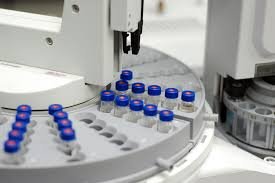Calibration of Gas Chromatography (GC)

Calibration of Gas Chromatography (GC)
1. Introduction
Gas Chromatography (GC) is used for separation, identification, and quantification of volatile and semi-volatile compounds. Calibration ensures that the GC system provides accurate, precise, and reproducible results in line with GMP and pharmacopeial requirements.
2. Objective
To verify that the GC system is performing within defined specifications by checking detector response, retention time stability, and peak area reproducibility against known standards.
3. Types of Calibration
-
External Standard Method
-
Known concentrations of analyte standards are injected.
-
A calibration curve (peak area vs. concentration) is plotted.
-
Sample concentrations are determined using the curve.
-
-
Internal Standard Method
-
A fixed quantity of an internal standard is added to both standards and samples.
-
Ratio of analyte to internal standard response is used for quantification.
-
-
Standard Addition Method
-
Known quantities of analyte are added to the sample to account for matrix effects.
-
4. Key Calibration Parameters
-
Retention Time (RT): Verify system stability by checking variation within limits (e.g., %RSD ≤ 1%).
-
Peak Area / Height: Used to assess detector linearity and sensitivity.
-
Resolution: Verify separation between peaks (as per system suitability).
-
Tailing Factor: Ensure peak symmetry (typically ≤ 2.0).
-
Theoretical Plates (Efficiency): Assess column performance.
5. Calibration Procedure (Example: External Standard Method)
-
Preparation of Standard Solutions
-
Prepare a set of known concentrations of reference standard in a suitable solvent.
-
-
System Conditioning
-
Stabilize column temperature, carrier gas flow, and detector parameters.
-
-
Injection
-
Inject each standard in triplicate to evaluate repeatability.
-
-
Plot Calibration Curve
-
Peak area (y-axis) vs. concentration (x-axis).
-
-
Acceptance Criteria
-
Correlation coefficient (r²) ≥ 0.999.
-
%RSD for peak areas ≤ 2% for repeatability.
-
-
Documentation
-
Calibration date, instrument ID, standard batch details, chromatograms, and calculations.
-
6. Frequency of Calibration
-
Daily: System suitability test before analysis.
-
Periodic: As per SOP or regulatory requirement (e.g., monthly or quarterly).
-
After Maintenance: Following detector, column, or flow controller replacement.
7. References
-
USP <621> Chromatography
-
ICH Q2(R1) – Validation of Analytical Procedures
-
ISO/IEC 17025 – General requirements for competence of testing laboratories

